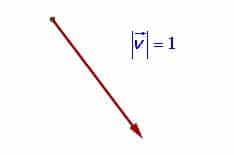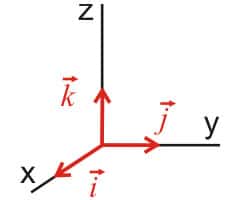UNIT VECTOR
The vectors are, in the field of physics , quantities defined by its point of application, sense, address and value. Depending on the context in which they appear and their characteristics, they are classified in different ways.

The idea of a unit vector refers to the vector whose modulus is equal to 1 . It should be remembered that the modulus is the number that matches the length when the vector is represented in a graph. The modulus, in this way, is a rule of mathematics that is applied to the vector that appears in a Euclidean space.
Another name by which the unit vector is known is the normalized vector , and it appears very frequently in problems in various fields, from mathematics to computer programming. It is possible to obtain the internal product or scalar product of two unit vectors by finding out the cosine of the angle formed between them. The product of a unit vector by a unit vector, thus, is the scalar projection of one of the vectors on the direction established by the other vector.
When you have a vector and you want to normalize it, what you do is look for a unit vector that has the same sense and the same direction as the vector in question. Vector normalization is carried out by dividing the vector by its modulus. The result is a unit vector with the same direction and the same sense.
But what does it mean to divide the vector by its modulus? Let's not forget that the vector is defined by means of components, as many as there are dimensions in the space in which it is found. If we take a two-dimensional vector, expressed in the X and Y axes , then it will have a value for each of them, such as (4,3). It should be mentioned that these components are also known as vector terms .
Therefore, if we go back to the method to find the unit vector that consists of dividing the original by its module, we simply have to take each of the components and divide them by that value , so that the final result offers us a module equal to 1 This may seem too abstract or arbitrary to non-mathematicians, but after careful analysis it makes absolutely sense. Let's see the explanation below.
If we base ourselves on the rules of division for a moment, we will remember that every number is divisible by itself and by 1 , and that if we divide it by itself the result we obtain is precisely 1. Now, in this case we are looking for a vector whose components orient it in the same direction as the original, but which generate a different length, more specifically, of value 1.
 Going back to the procedure of dividing each component by module, let's see how to get to that step in a logical way. First of all, it is necessary to remember that to calculate the modulus of a vector we are based on the Pythagorean Theorem , since we consider the segment of the vector as the hypotenuse, and each of its components as the legs of the triangle.
Going back to the procedure of dividing each component by module, let's see how to get to that step in a logical way. First of all, it is necessary to remember that to calculate the modulus of a vector we are based on the Pythagorean Theorem , since we consider the segment of the vector as the hypotenuse, and each of its components as the legs of the triangle.
Therefore, to calculate the module of the vector (4,3) we must obtain the square root of the sum of the squares of 4 and 3. This gives us the result 5. To arrive at the unit vector, we must multiply everything by 1 / 5 (one fifth), so that on one side of the equality we obtain 1 (the length of the normalized vector) and on the other we find 1/5 x (4,3) .
Finally, we can say that the components of the unit vector will be (4 / 5,3 / 5), and it is enough to apply the Pythagorean Theorem to verify that the module is indeed 1.
The use of unit vectors facilitates the specification of the different directions that vector quantities have in a given coordinate system .
Comments
Post a Comment